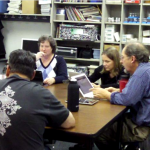![]() I’ve had mixed results using social networking media for class discussions. Because of that I haven’t even tried to have students use it for backchanneling. It’s hard enough to get them to listen as I give instructions and I don’t lecture all that much anyway. I’ve had this vision of engaging more students in class discussions, especially the quiet ones, by using chats, Twitter, or other social media, so that we didn’t have to call on raised hands or shush kids or talk one at a time. I sure could use some help getting ideas on how to make it work.
I’ve had mixed results using social networking media for class discussions. Because of that I haven’t even tried to have students use it for backchanneling. It’s hard enough to get them to listen as I give instructions and I don’t lecture all that much anyway. I’ve had this vision of engaging more students in class discussions, especially the quiet ones, by using chats, Twitter, or other social media, so that we didn’t have to call on raised hands or shush kids or talk one at a time. I sure could use some help getting ideas on how to make it work.
Two years ago I tried using my moodle to create a chat room to have a class discussion. I thought I gave kids enough time to “play” and get the hi’s and silly typing out of their system. They never did so it was very difficult to follow any thread of on topic conversation. I even had one class where an inappropriate word popped up on the screen so I shut it down. The user was anonymous so we never got the guilty party to cop to it. Yes, I know. I shouldn’t take the easy way out and have students be able to join anonymously but I always trust first. If something bad happens I use it as a teachable moment. Still sucks, though.
Then last year I tried using Twitter. With Twitter I couldn’t get the kids to tweet! They just never got into it so they wouldn’t tweet during discussions. They also wouldn’t tweet to share resources or links or ideas. Along those same lines, they wouldn’t even check their Twitter accounts! I don’t know if it was just that group of students (two classes of 8th graders) or if this is common. What should I have done?
So this year I went a different route. I was deciding between using Edmodo or Collaborize Classroom. I had read over the summer that Edmodo didn’t have threaded discussions so I went with Collaborize. I made the graphic on this post as the logo for our class Collaborize Classroom network, which I made a closed network just for our classes. (Our class blogs are open to the world.) Now kids asked me why we didn’t just use Facebook. I then asked what they mostly do on Facebook. They said, “socialize,” to which I responded, “exactly.” Yet, by my own doing, I created such a network in my classroom! Here’s how.
With Collaborize students get to start discussion topics of their own. I thought that was great because they would get tired of always responding to topics that I chose for them. I set the permissions such that I had to approve topics before they went live. Students started to play. They posted fun questions and polls for their fellow classmates and even across to my other classes. I encouraged it because I saw them engaging with our network. I couldn’t keep up. They were coming so fast and so frequently that I took off the permission thing. They were now free to post topics all they wanted. I couldn’t get one of my topics looked at because so many more exciting, fun topics flooded my Science topics before and after I’d post them. I felt like I was forcing kids to respond to my posted topics and I was.
I ended up letting the excitement wane and kids stopped posting topics to our network. I turned our network into a Facebook-like, fun, social space not the Science learning/discussion space I had intended. I am still new at this and I’m at the point where I’ve given up on this year. I’m going to try again next year and am wondering what others do. How do teachers create a functioning class social network? How do you get kids to engage with the network without having it turn into a Facebook?


















































